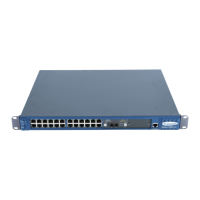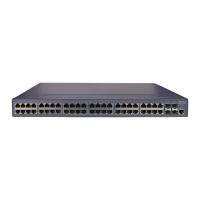Operation Manual - STP
Quidway S3000 Series Ethernet Switches Chapter 1 RSTP Configuration
1-8
z Set Forward Delay of a specified bridge
z Set Hello Time of the specified bridge
z Set Max Age of the specified bridge
z Set the maximum transmission speed of the specified port
z Set specified port as the EdgePort
z Set path cost of the specified port
z Set the priority of a specified port
z Configure a specified port to be connected to a point-to-point link
z Set mCheck of the specified port
Among the above-mentioned tasks, only the steps of enabling STP on the switch and
enabling STP on the port are required. For other tasks, if you do not configure them, the
system will use the default settings.
Before enabling spanning tree, relative parameters of Ethernet port or the device can
be configured. After disabling the spanning tree, these configuration parameters will be
reserved and becoming functional after enabling the spanning tree again.
1.2.1 Enable/Disable RSTP on a Switch
You can use the following command to enable RSTP on the switch.
Perform the following configurations in system view.
Table1-1 Enable/Disable RSTP on a device
Operation Command
Enable/Disable RSTP on a device stp { enable | disable }
Restore RSTP to the default value undo stp
Only after the RSTP is enabled on the switch can other configurations take effect.
Note that some network resource will be occupied after RSTP is enabled.
By default, RSTP is disabled.
1.2.2 Enable/Disable RSTP on a Port
You can use the following command to enable/disable the RSTP on the designated port.
To flexibly control the RSTP operations, after RSTP is enabled on the Ethernet ports of
the switch, it can be disabled again to forbid the ports to participate in the spanning tree
calculation.
Perform the following configurations in Ethernet port view.

